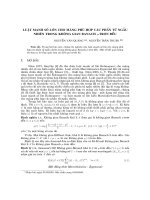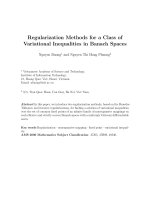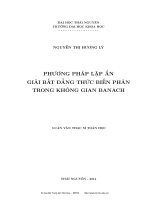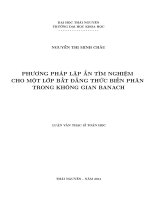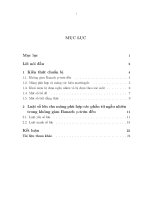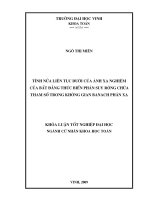Biến phân bất bình đẳng trong không gian banach
Bạn đang xem bản rút gọn của tài liệu. Xem và tải ngay bản đầy đủ của tài liệu tại đây (135.31 KB, 13 trang )
Regularization Methods for a Class of
Variational Inequalities in Banach Spaces
Nguyen Buong
1
and Nguyen Thi Hong Phuong
2
1
Vietnamese Academy of Science and Technology,
Institute of Information Technology,
18, Hoang Quoc Viet, Hanoi, Vietnam.
Email:
2
9/5, Tran Quoc Hoan, Cau Giay, Ha Noi, Viet Nam.
Abstract In this paper, we introduce two regularization methods, based on the Browder-
Tikhonov and iterative regularizations, for finding a solution of variational inequalities
over the set of common fixed points of an infinite family of nonexpansive mappings on
real reflexive and strictly convex Banach spaces with a uniformly Gˆateaux differentiable
norm.
Key words Regularization · nonexpansive mapping · fixed point · variational inequal-
ity.
AMS 2000 Mathematics Subject Classification: 47J05, 47H09, 49J30.
1
Regularization Fixed Point Iteration for Nonlinear Ill-Posed 2
1. INTRODUCTION AND PRELIMINARIES
Let E be a Banach space with the dual space E
∗
. For the sake of simplicity, the
norms of E and E
∗
are denoted by the symbol .. We write x, x
∗
instead of x
∗
(x)
for x
∗
∈ E
∗
and x ∈ E.
For a real number q with 1 < q, a mapping J
q
from E into E
∗
, satisfying the
condition
J
q
(x) = {x
∗
∈ E
∗
: x, x
∗
= x
q
and x
∗
= x
q−1
},
is called a generalized duality mapping of E. The mapping exists for any Banach space
and, in general, is multi-valued. It is well known that J
q
(tx) = tJ
q
(x), for all t > 0
and x ∈ E, and J
q
(−x) = −J
q
(x). When q = 2, J
2
is called the normalized duality
mapping and is usually denoted by J. In the case that E ≡ H, a Hilbert space, we
have J = I, the identity mapping.
Let C be a nonempty, closed and convex subset of E and T, F : C → E be two
nonlinear mappings. Recall that a mapping T , satisfying the condition
T x − T y ≤ x − y,
for all x, y ∈ C, is said to be nonexpansive. Put Fix(T ) = {x ∈ C : x = T x}, the set of
fixed points of T . In addition, if T : C → C, then T is called a nonexpansive mapping on
C. The mapping F is said to be η-strongly accretive and γ-strictly pseudocontractive,
iff it satisfies, respectively, the following conditions:
F (x) − F (y), j(x − y) ≥ ηx − y
2
,
and
F (x) − F (y), j(x − y) ≤ x − y
2
− γ(I − F)x − (I − F)y
2
,
for all x, y ∈ C and some element j(x − y) ∈ J(x − y), where γ and η are some
fixed positive constants with γ ∈ (0, 1). If F is γ-strictly pseudocontractive, then
F (x) − F (y) ≤ Lx − y with L = 1 + 1/γ and, in this case, F is called L-Lipschitz
continuous.
The variational inequality problem is formulated as finding a point p
∗
∈ C such
that
F (p
∗
), j(p
∗
− p) ≤ 0 ∀p ∈ C, (1)
for some j(p
∗
− p) ∈ J(p
∗
− p). The theory of variational inequalities was firstly posed
and studied in [1-3]. In [3] Stampacchia proved his generalization to the Lax-Milgram
theorem in order to study the regularity problem for partial differential equations. In
1965, Stampacchia and Lions extended the result of [3] and announced the full proofs
of their results in [4]. Ever since, variational inequalities have been widely investigated,
because it covers as diverse disciplines, as partial differential equations, optimal control,
optimization, mathematical programming, mechanics, and finance (see, e.g., [5-10]).
It is well-known (see [11], Lemma 2.7) that a variational inequality in a smooth
Banach space is equivalent to the following fixed-point equation
p
∗
= Q
C
(I − λF(p
∗
)), (2)
Regularization Fixed Point Iteration for Nonlinear Ill-Posed 3
where Q
C
is a sunny nonexpansive retraction from any point of the space onto C. The
sunny nonexpansive retraction is not easy to compute, due to the complexity of the
feasible set. To overcome this drawback in a Hilbert space, where the retraction is
a metric projection, in [12], Yamada assumed that the feasible set C were the set of
common fixed points of a finite family of nonexpansive mappings {T
i
}
N
i=1
, proposed the
following iterative algorithm
u
k+1
= T
[k+1]
u
k
− λ
k+1
µF (T
[k+1]
u
k
), (3)
where T
[n]
= T
n modN
, taking values in {1, 2, ···, N}, u
0
is an arbitrary initial point in H,
µ ∈ (0, 2η/L
2
) and {λ
k
}
k∈N
⊂ (0, 1), and proved that, under the following conditions:
(L1) lim
k→∞
λ
k
= 0,
(L2)
∞
k=1
λ
k
= ∞,
(L3)
∞
k=1
|λ
k
− λ
k+N
| < ∞,
the sequence {u
k
}
k∈N
of (3) converges strongly to p
∗
in (1). Next, in [13], Xu and Kim,
by replacing condition (L3) by
(L4) lim
k→∞
(λ
k
− λ
k+N
)/λ
k+N
= 0,
proved also a strong convergence result.
In the case that C = ∩
∞
i=1
F ix(T
i
), where {T
i
}
∞
i=1
is an infinite family of nonexpan-
sive mappings on H, by using Takahashi’s W -mapping, generated by T
k
, T
k−1
, · · ·, T
1
and real numbers α
k
, α
k−1
, · · ·, α
1
, as follows:
U
k,k+1
= I,
U
k,k
= α
k
T
k
U
k,k+1
+ (1 − α
k
)I,
U
k,k−1
= α
k−1
T
k−1
U
k,k
+ (1 − α
k−1
)I,
. . . . . . . . . . . . . . . . . . . . . . . . . .
U
k,2
= α
2
T
2
U
k,3
+ (1 − α
2
)I,
W
k
= U
k,1
= α
1
T
1
U
k,2
+ (1 − α
1
)I,
with 0 < α
i
≤ b < 1 for i ≥ 1, in [14], Yao et al. obtained the following result.
Theorem 1 Let H be a real Hilbert space and F : H → H be a mapping such that, for
some positive constants L and η, F be L-Lipschitz continuous and η-strongly mono-
tone. Let {T
i
}
∞
i=1
be an infinite family of nonexpansive mappings on H such that
C = ∩
∞
i=1
F ix(T
i
) = ∅. Then, the sequence {x
k
}, defined by
x
k+1
= (1 − γ
k
)F
k
(x
k
) + γ
k
W
k
F
k
(x
k
),
where F
k
= I − λ
k
F , λ
k
∈ (0, 1), satisfying (L1) and (L2), and γ
k
∈ [γ, 1/2], converges
strongly to the unique element p
∗
in (1).
Very recently, in [15], Wang obtained the same result, under the conditions that
λ
k
F (x
k
) → 0 as k → ∞ and that (L1) is replaced by 0 < λ
k
≤ η/L
2
− ε for a
small positive constant ε and k ≥ k
0
> 1.
Regularization Fixed Point Iteration for Nonlinear Ill-Posed 4
It is well-known (see [16]) that the fixed point problem for nonexpansive mappings
is ill-posed. Then, problem (1) with C = ∩
∞
i=1
F ix(T
i
) is ill-posed, too. To solve the
class of ill-posed problems, we have to use stable methods, a well-known one of which
is the Tikhonov regularization; see, for example, [17-18].
In this paper, for solving (1) with C = ∩
∞
i=1
F ix(T
i
), where each T
i
is a nonexpansive
mapping on a real reflexive and strictly convex Banach space E with a uniformly
Gˆateaux differentiable norm, we consider two regularization methods, constructed on
the base of combinations of the Tikhonov regularization with Browder approximation
(see [19]) and simple iteration, respectively. The first method is defined by solving the
following equation
A
k
(x
k
) + ε
k
F (x
k
) = 0, A
k
= I − V
k
, (4)
where
V
k
= V
1
k
, V
i
k
= T
i
T
i+1
· · · T
k
, T
i
= (1 − α
i
)I + α
i
T
i
, (5)
for all i ≤ k with i, k ∈ N, the set of all positive integers,
α
i
∈ (0, 1) with
∞
i=1
α
i
< ∞, (6)
and the regularization parameter ε
k
→ 0 as k → ∞. In the second method, the
iteration sequence {z
k
} is generated by
z
k+1
= z
k
− β
k
[A
k
(z
k
) + ε
k
F (z
k
)] k ≥ 1, (7)
where the iteration parameter β
k
satisfies some conditions, for any z
1
∈ E.
We recall the following facts which will be used to prove our result.
Let E be a real normed linear space. Let S
1
(0) := {x ∈ E : x = 1}. The space E
is said to have a Gˆateaux differentiable norm (or to be smooth) if the limit
lim
t→0
x + ty − x
t
exists for each x, y ∈ S
1
(0). The space E is said to have a uniformly Gˆateaux differen-
tiable norm if the limit is attained uniformly for x ∈ S
1
(0). Assume that dim(E) ≥ 2.
The modulus of smoothness of E is the function ρ
E
: [0, ∞) → [0, ∞), defined by
ρ
E
(τ) = sup
1
2
(x + y + x − y) − 1 : x ≤ 1, y ≤ τ
.
In term of the modulus of smoothness, the Banach space E is called uniformly smooth,
iff
lim
τ→0
(ρ
E
(τ)/τ) = 0.
E is said to be q-unifomly smooth if there exists a constant c > 0 such that ρ
E
(τ) ≤ cτ
q
.
Hilbert spaces, L
p
(or l
p
) spaces, 1 < p < ∞, and the Sobolev spaces, W
p
m
, 1 < p < ∞,
are q-uniformly smooth. Hilbert spaces are 2-uniformly smooth while L
p
or l
p
or W
p
m
Regularization Fixed Point Iteration for Nonlinear Ill-Posed 5
is p-uniformly smooth if 1 < p ≤ 2, 2-uniformly smooth if p ≥ 2. The space E is said
to be strictly convex, iff for x, y ∈ S
1
(0) with x = y, we have
(1 − λ)x + λy < 1 ∀λ ∈ (0, 1).
It is well-known (see, [20]) that if E is smooth, then the normalized duality mapping is
single valued; and if the norm of E is uniformly Gˆateaux differentiable, then the nor-
malized duality mapping is norm to weak star uniformly continuous on every bounded
subset of E. In the sequel, we shall denote the single valued normalized duality map-
ping and single valued generalized duality mapping by j and j
q
, respectively.
Let µ be a continuous linear functional on l
∞
and let (a
1
, a
2
, ) ∈ l
∞
. We write
µ
k
(a
k
) instead of µ((a
1
, a
2
, )). We recall that µ is a Banach limit when µ satisfies
µ = µ
k
(1) = 1 and µ
k
(a
k+1
) = µ
k
(a
k
) for each (a
1
, a
2
, ) ∈ l
∞
. For a Banach limit
µ, we know that
lim inf
k→∞
a
k
≤ µ
k
(a
k
) ≤ lim sup
k→∞
a
k
for all (a
1
, a
2
, ) ∈ l
∞
. If a = (a
1
, a
2
, ) ∈ l
∞
, b = (b
1
, b
2
, ) ∈ l
∞
and a
k
→ c
(respectively, a
k
− b
k
→ 0), as k → ∞, we have µ
k
(a
k
) = µ(a) = c (respectively,
µ
k
(a
k
) = µ
k
(b
k
)).
We will make use the following well-known results.
Lemma 1 [21]. Let C be a convex subset of a Banach space E whose norm is uniformly
Gˆateaux differentiable. Let {x
k
} be a bounded subset of E, let z be an element of C
and let µ be a Banach limit. Then,
µ
k
x
k
− z
2
= min
u∈C
µ
k
x
k
− u
2
iff µ
k
u − z, j(x
k
− z) ≤ 0 for all u ∈ C.
Lemma 2 [22]. Let {a
k
}, {b
k
} and {c
k
} be the sequences of positive numbers satisfying
the conditions
(i) a
k+1
≤ (1 − b
k
)a
k
+ c
k
, b
k
< 1,
(ii)
∞
n=0
b
k
= +∞, lim
k→+∞
(c
k
/b
k
) = 0.
Then, lim
k→+∞
a
k
= 0.
Theorem 2 [23] Let 1 < q ≤ 2 and E be a real smooth Banach space. Then the
following are equivalent:
(1) E is q-uniformly smooth.
(2) There exists a constant c
q
> 0 such that for all x, y ∈ E
x + y
q
≤ x
q
+ qy, j
q
(x) + c
q
y
q
.
2. MAIN RESULTS
By using the techniques in [25-27] for W -mapping, we have the following lemmas.
Regularization Fixed Point Iteration for Nonlinear Ill-Posed 6
Lemma 3 Let C be a closed and convex subset of a real strictly convex Banach space E
and let {T
i
}
k
i=1
, k ≥ 1, be k nonexpansive mappings on C such that the set of common
fixed points F := ∩
k
i=1
F ix(T
i
) = ∅. Let a, b and α
i
, i = 1, 2, ·· ·, k, be real numbers such
that 0 < a ≤ α
i
≤ b < 1, and let V
k
be a mapping, defined by (5). Then, F ix(V
k
) = F.
Proof. The case k = 1 is clear. We consider the case that k > 1. First, we prove that
F ⊂ F ix(V
k
). Indeed, for each p ∈ F, we have that
T
i
p = [(1 − α
i
)I + α
i
T
i
]p = p ∀i = 1, 2, · · ·, k. (8)
Consequently, V
k
p = T
1
T
2
· · · T
k
p = p. Now, we shall prove that F ix(V
k
) ⊂ F. Take
any z ∈ F ix(V
k
) and p ∈ F. Then, from (8) it follows that
z − p = T
1
T
2
· · · T
k
z − p
= T
1
T
2
· · · T
k
z − T
1
p
≤ T
2
· · · T
2
z − p
= T
2
· · · T
N
z − T
2
p
. . . . . . . . . . . . . .
≤ T
k−1
T
k
z − p
= T
k−1
T
k
z − T
k−1
p
≤ T
k
z − T
k
p
≤ z − p.
(9)
Therefore,
z − p = [(1 − α
k
)I + α
k
T
k
]z − p = (1 − α
k
)(z − p) + α
k
(T
k
z − p).
Since E is strictly convex and α
k
∈ (a, b) with a, b ∈ (0, 1), we obtain that
T
k
z − p = z − p,
and hence T
k
z = z. So, z ∈ F ix(T
k
) for each z ∈ F ix(V
k
). Moreover, this implies that
[(1 − α
k−1
)I + α
k−1
T
k−1
]T
k
z − p = [(1 − α
k−1
)I + α
k−1
T
k−1
]z − p.
Now, from (9) it follows that
z − p = [(1 − α
k−1
)I + α
k−1
T
k−1
]z − p = (1 − α
k−1
)(z − p) + α
k−1
(T
k−1
z − p).
Again, since E is strictly convex and α
k−1
∈ (a, b) with a, b ∈ (0, 1), we have
T
k−1
z − p = z − p,
and hence T
k−1
z = z. So, z ∈ F ix(T
k−1
). Similarly, we obtain that z ∈ F ix(T
i
) for all
i = 1, · · ·, k. It means that F ix(V
k
) ⊂ F. Lemma is proved.
Lemma 4 Let C be a closed and convex subset of a real Banach space E and let {T
i
}
∞
i=1
be an infinite family of nonexpansive mappings on C such that the set of common fixed
points F := ∩
∞
i=1
F ix(T
i
) = ∅. Let V
k
be a mapping, defined by (5)-(6). Then, for each
x ∈ C and i ∈ N, the set of all positive integers, lim
k→∞
V
i
k
x exists.
Regularization Fixed Point Iteration for Nonlinear Ill-Posed 7
Proof. Let p ∈ F and x ∈ C such that p = x. Then, for k ∈ N with fixed k ≥ i, we
have
V
i
k+1
x − V
i
k
x = T
i
T
i+1
· · · T
k
T
k+1
x − T
i
T
i+1
· · · T
k
x
≤ T
k+1
x − x
= (1 − α
k+1
)x + α
k+1
T
k+1
x − x
= α
k+1
T
k+1
x − T
k+1
p + p − x
≤ 2α
k+1
x − p.
Since
∞
i=1
α
i
< ∞, we have lim
n,m→∞
m
j=n
α
j
= 0. So, for any ε > 0, there exists
k
0
∈ N with k
0
≥ i such that, for any n, m with m > n > k
0
, we have
m−1
j=n
α
j+1
<
ε
2x − p
.
Thus,
V
i
m
x − V
i
n
x ≤
m−1
j=n
V
i
j+1
x − V
i
j
x ≤
m−1
j=n
(2α
j+1
x − p)
= 2x − p
m−1
j=n
α
j+1
< ε.
Therefore, {V
i
k
x}, for each fixed i, is a Cauchy sequence in the Banach space E and
hence lim
k→∞
V
i
k
x exists.
Now, we can define the mappings
V
i
∞
x := lim
k→∞
V
i
k
x, and V x := lim
k→∞
V
k
x = lim
k→∞
V
1
k
x.
Obviously, V
k
, V
i
k
, V
i
∞
and V are nonexpansive on E. Put A = I − V .
Lemma 5 Let C, T
i
and α
i
be as in Lemma 4 and let E be a strictly convex Banach
space. Then, F ix(V ) = F.
Proof. Let p ∈ F. Then, it is obvious that V
i
k
p = p for all i, k ∈ N with k ≥ i. So, we
have V
i
∞
p = p for all i ∈ N. In particular, we have V p = V
1
∞
p and hence F ⊂ F ix(V ).
Next, we prove that Fix(V ) ⊂ F. Now, let x ∈ F ix(V ) and y ∈ F. Then,
V
k
x − V
k
y = V
1
k
x − V
1
k
y
= (1 − α
1
)(V
2
k
x − V
2
k
y) + α
1
(T
1
V
2
k
x − T
1
V
2
k
y)
≤ (1 − α
1
)V
2
k
x − V
2
k
y + α
1
V
2
k
x − V
2
k
y
= V
2
k
x − V
2
k
y ≤ V
i+1
k
x − V
i+1
k
y
≤ V
k
k
x − V
k
k
y ≤ x − y,
which together with V x − V y = x − y implies that
V
i
∞
x − V
i
∞
y = V
i+1
∞
x − V
i+1
∞
y = x − y.
Regularization Fixed Point Iteration for Nonlinear Ill-Posed 8
So, we have
(1 − α
i
)(V
i+1
∞
x − V
i+1
∞
y) + α
i
(T
i
V
i+1
∞
x − T
i
V
i+1
∞
y) = V
i+1
∞
x − V
i+1
∞
y
= x − y,
for every i ∈ N. Since E is strictly convex, 0 < α
i
< 1, and y ∈ F, we have
x − y = T
i
V
i+1
∞
x − T
i
V
i+1
∞
y = T
i
V
i+1
∞
x − y,
= V
i+1
∞
x − V
i+1
∞
y = V
i+1
∞
x − y,
and hence x = T
i
V
i+1
∞
x and x = V
i+1
∞
x for every i ∈ N. Consequently, for every i ∈ N,
we have x = T
i
x. It means that x ∈ F.
Now, we are in a position to prove the following result.
Theorem 3 Let E be a real reflexive and strictly convex Banach space with a uniformly
Gˆateaux differentiable norm, let F be an η-strongly accretive and γ-strictly pseudocon-
tractive mapping with η + γ > 1 and let {T
i
}
∞
i=1
be an infinite family of nonexpansive
mappings on E such that C := ∩
∞
i=1
F ix(T
i
) = ∅. Assume that α
i
satisfies (6). Then,
for any ε
k
> 0, equation (4) possesses a unique solution x
k
. Moreover, if ε
k
→ 0 as
k → ∞, then the sequence {x
k
} converges strongly to p
∗
, solving (1).
Proof. It is easy to see that the mapping A
k
+ ε
k
F , for each ε
k
> 0, is ε
k
-strongly
accretive on E. So, it is m-accretive. Therefore, (4) has a unique solution x
k
, for each
ε
k
> 0. Next we show that the set {x
k
} is bounded. Indeed, for any p ∈ C, we have
A
k
(p) = 0, and hence, from (4) it follows that
A
k
(x
k
) − A
k
(p), j(x
k
− p) + ε
k
F (x
k
), j(x
k
− p) = 0.
This together with the accretive property of A
k
and ε
k
> 0 implies that
F (x
k
), j(x
k
− p) ≤ 0.
Therefore,
x
k
− p
2
≤ F (p), j(p − x
k
)/η, (10)
because F is η-strongly accretive. Consequently, x
k
− p ≤ F(p)/η. It means that
{x
k
} is bounded. So, are the sets {V
k
x
k
} and {F (x
k
)}. Without any loss of generality,
we assume that x
k
, V
k
x
k
, F (x
k
) ≤ M
1
, for some positive constant M
1
and all
k ≥ 1.
On the other hand, since A
k
(x
k
) = ε
k
F
k
(x
k
) ≤ ε
k
M
1
and ε
k
→ 0 as k → ∞,
we have that A
k
(x
k
) → 0. Now, we show that A(x
k
) → 0 as k → ∞. Indeed, it
can be seen from Lemma 4 that if D is a nonempty and bounded subset of E, then for
ε > 0, there exists k
0
> i such that
sup
x∈D
V
i
k
x − V
i
∞
x ≤ ε,
for all k > k
0
. Taking D = {x
k
: k ≥ 1} and i = 1, we have
V
k
x
k
− V x
k
≤ sup
x∈D
V
k
x − V x ≤ ε.
Regularization Fixed Point Iteration for Nonlinear Ill-Posed 9
This implies that V
k
x
k
− V x
k
→ 0, as k → ∞. Further, since
A(x
k
) ≤ A
k
(x
k
) + V
k
x
k
− V x
k
,
we obtain that
lim
k→∞
x
k
− V x
k
= 0. (11)
Now, define a mapping ϕ : E → R by
ϕ(u) = µ
k
x
k
− u
2
∀u ∈ E.
We see that ϕ(u) → ∞ as u → ∞, ϕ is continuous and convex, so as E is reflexive,
there exists ˜p ∈ E such that ϕ(˜p) = min
u∈E
ϕ(u). Hence, the set
C
∗
:= {x ∈ E : ϕ(x) = min
u∈E
ϕ(u)} = ∅.
It is easy to see that C
∗
is a bounded, closed, and convex subset of E. From (11), we
have that
ϕ(V ˜p) = µ
k
x
k
− V ˜p
2
= µ
k
V x
k
− V ˜p
2
≤ µ
k
x
k
− ˜p
2
= ϕ(˜p)
which implies that V C
∗
⊂ C
∗
, that is C
∗
is invariant under V . Now, we show that C
∗
contains a fixed point of V . Since E is a strictly convex and reflexive Banach space,
for a point p ∈ F ix(V ), there exists a unique p ∈ C
∗
([17], p. 24) such that
p − p = inf
x∈C
∗
p − x.
By p = V p and V p ∈ C
∗
, we have
p − V p = V p − V p ≤ p − p,
and hence V p = p. Thus, there exists a point ˜p ∈ C ∩ C
∗
. From Lemma 1.1, we know
that ˜p is a minimizer of ϕ(u) on E, if and only if
µ
k
u − ˜p, j(x
k
− ˜p) ≤ 0 ∀u ∈ E. (12)
Taking u = (I − F )(˜p) in (12), we obtain that
µ
k
F (˜p), j(˜p − x
k
) ≤ 0. (13)
Using (10) and (11), we obtain that µ
k
x
k
− ˜p
2
= 0. Hence, there exists a subsequence
{x
k
i
} of {x
k
} which strongly converges to ˜p as i → ∞. Again, from (8) and the norm
to weak star continuous property of the normalized duality mapping j on bounded
subsets of E, we obtain that
F (p), j(˜p − p) ≤ 0 ∀p ∈ C. (14)
Since p and ˜p belong to F, a closed and convex subset, by replacing p in (14) by
sp + (1 − s)˜p for s ∈ (0, 1), using the well-known property j(s(˜p − p)) = sj(˜p − p) for
s > 0, dividing by s and taking s → 0, we obtain
F (˜p), j(˜p − p) ≤ 0 ∀p ∈ C.
The uniqueness of p
∗
in (1) guarantees that ˜p = p
∗
. So, all the sequence {x
k
} converges
strongly to p
∗
as k → ∞. This completes the proof.
Regularization Fixed Point Iteration for Nonlinear Ill-Posed 10
Theorem 4 Let E be a real reflexive and strictly convex Banach space with a q-
uniformly Gˆateaux differentiable norm for a fixed q : 1 < q ≤ 2, let F be an η-strongly
accretive and γ-strictly pseudocontractive mapping with η + γ > 1 and let {T
i
}
∞
i=1
be an
infinite family of nonexpansive mappings on E with C := ∩
∞
i=1
F ix(T
i
) = ∅. Assume
that (6) and the following conditions hold:
0 < β
k
< β
0
, ε
k
0, lim
k→∞
ε
k
− ε
k+1
ε
2
k
β
k
= lim
k→∞
α
k+1
β
k
ε
2
k
= 0,
∞
k=0
ε
k
β
k
= ∞, lim sup
k→∞
c
q
β
q−1
k
(2 + ε
k
)
q
ε
k
< 1.
Then, the sequence {z
k
}, defined by (5), converges strongly to p
∗
, the solution of (1).
Proof. Let x
k
be the solution of (5). Then, by Theorem 2, we have
z
k+1
− x
k
q
= z
k
− x
k
− β
n
[(I − V
k
)z
n
+ ε
k
F (z
k
)]
q
= z
k
− x
k
− β
n
[(I − V
k
)z
k
− (I − V
k
)x
k
+ ε
k
(F (z
k
) − F (x
k
)]
q
≤ z
k
− x
k
q
− qβ
k
(I − V
k
)z
k
− (I − V
k
)x
k
+ ε
k
(F (z
k
) − F (x
k
)), j
q
(z
n
− x
n
)
+ c
q
β
q
k
(I − V
k
)z
n
− (I − V
k
)x
k
+ ε
k
(F (z
k
) − F (x
k
))
q
,
where
(I − V
k
)z
k
− (I − V
k
)x
k
, j
q
(z
k
− x
k
) = z
k
− x
k
q−2
×
(I − V
k
)z
k
− (I − V
k
)x
k
, j(z
k
− x
k
) ≥ 0,
since the mapping I − V
k
is acrretive on E, and
F (z
k
) − F (x
k
), j
q
(z
k
− x
k
) ≥ ηz
k
− x
k
q
.
Therefore,
z
k+1
− x
k
q
≤ z
k
− x
k
q
[1 − qβ
n
ε
k
+ c
q
β
q
k
(2 + ε
k
)
q
],
because I − V
k
is 2-Lipschitz continuous. Thus,
z
k+1
− x
k
≤ z
k
− x
k
[1 − qβ
k
ε
k
+ c
q
β
q
k
(2 + ε
k
)
q
]
1/q
.
As c
q
β
q
k
(2 + ε
k
)
q
< β
k
ε
k
and (1 − t)
γ
≤ 1 − γt, for 0 < γ < 1, then
z
k+1
− x
k
≤ z
k
− x
k
[1 − (q − 1)β
k
ε
k
]
1/q
≤ z
k
− x
k
[1 − (q − 1)β
k
ε
k
/q].
Now, we estimate the value x
k+1
− x
k
. From (5), we have
x
k
− x
k+1
2
= V
k
x
k
− V
k+1
x
k+1
, j(x
k
− x
k+1
)
− ε
k
F (x
k
) − ε
k+1
F (x
k+1
), j(x
k
− x
k+1
)
≤ x
k
− x
k+1
2
+ 2b
k+1
x
k+1
− px
k
− x
k+1
− ε
k
F (x
k
) − F (x
k+1
), j(x
k
− x
k+1
)
+ (ε
k+1
− ε
k
)F (x
k+1
), j(x
k
− x
k+1
),
Regularization Fixed Point Iteration for Nonlinear Ill-Posed 11
that togerther with the η-strongly accretive property of F implies that
x
k
− x
k+1
≤ 2b
k+1
(M
1
+ p)/ε
k
+ M
1
(ε
k
− ε
k+1
)/ε
k
.
Hence,
z
k+1
− x
k+1
≤ z
k+1
− x
k
+ x
k+1
− x
k
≤ [1 − (q − 1)β
k
ε
k
/q]z
k
− x
k
+ 2b
k+1
(M
1
+ p)/ε
k
+ M
1
(ε
k
− ε
k+1
)/ε
k
.
Applying Lemma 1.2 with
a
k
= z
k
− x
k
, b
k
= (q − 1)β
k
ε
k
/q, c
k
= 2α
k+1
(M
1
+ p)/ε
k
+ M
1
(ε
k
− ε
k+1
)/ε
k
.
we obtain that lim
k→∞
z
k
− x
k
= 0. Since, by Theorem 3, lim
k→∞
x
k
= p
∗
, we have
lim
n→∞
z
n
= p
∗
.
Theorem is proved.
Remark. The sequences ε
k
= (1 + n)
−p
, 0 < p < 1/2, and β
n
= γ
0
ε
k
with
0 < γ
0
<
1
c
1/(q−1)
q
(2 + ε
0
)
q/(q−1)
satisfy all the necessary conditions in Theorem 4 for the case q = 2. For the case
1 < q < 2, ε
k
= (1 + k)
−p
with p < (q − 1)/(2q) and β
k
= γ
0
ε
1/(q−1)
k
also satisfy all the
necessary conditions in Theorem 2.2.
This research is founded by Vietnamese National Foundation of Science and Tech-
nology Development under grant number 101.01-2011.17.
Regularization Fixed Point Iteration for Nonlinear Ill-Posed 12
References
[1] Antman S., The influence of elasticity in analysis: modern developments// Bull.
Amer. Math. Soc. 1983, V. 9, N. 3, P. 267-291
[2] Fichera G., La nascita della teoria delle diseguaglianze variazionali ricordata dopo
trent’anni// Accademia Nazionale dei Lincei. 1995, V. 114, P. 47-53
[3] Stampacchia G., Formes bilineares coercitives sur les ensembles convexes// Com-
putes Rendus Hebdom. des S´eances de l’Acad´emie des Sci. 1964, V. 258, P. 4413-
4416
[4] Lions J.L., Stampacchia G., Variational inequalities// Commun. Pure Appl. Math.
1967, V. 20, P. 493-519
[5] Duvaut D., Lions J.L., Inequalities in mechanics and physics// Springer-Verlag,
Berlin 1976
[6] Kinderlehrer D., Stampacchia, G., An introduction to variational inequalities and
their applications// Academic Press, New York, NY, 1980
[7] Hlavacek I., Haslinger J., Necas J., Lovicek, J., Solution of variational inequalities
in mechanics// Springer-Verlag, New York 1982
[8] Glowinski R., Numerical methods for nonlinear variational problems// Springer,
New York, NY 1984
[9] Panagiotopoulos P.D., Inequality problems in mechanics and applications// Bir-
khauser, Boston 1985
[10] Zeidler E., Nonlinear functional analysis and its applications// Springer, New
York, NY 1985
[11] Aoyama K., Iiduka H., Takahashi W., Weak convergence of an iterative sequence
for accretive operators in Banach spaces// Fixed Point Theory and Appl. doi:
10.1155/35390, (2006)
[12] Yamada Y., The hybrid steepest-descent method for variational inequalities prob-
lems over the intesection of the fixed point sets of nonexpansive mappings, Inhently
parallel algorithms in feasibility and optimization and their applications. Edited
by D. Butnariu, Y. Censor, and S. Reich, North-Holland, Amsterdam, Holland,
pp. 473-504, 2001
[13] Xu H.K., Kim T.H., Convergence of hybrid steepest-descent methods for varia-
tional inequalities// J. Optim. Theory and Appl. 2003, V. 119, P. 185-201
[14] Yao Y., Noor M.A., Liou Y.C., Convergence of hybrid steepest-descent method
for variational inequalities// Appl. Math. Comput. 216 2010, V. 216, P. 822-829
[15] Wang Sh. , Convergence and weaker control conditions for hybrid iterative algo-
rithms, FPTA 2011, doi: 10.1186/1687-1812-2011-3.
Regularization Fixed Point Iteration for Nonlinear Ill-Posed 13
[16] Alber Ya.I., On the stability of iterative approximations to fixed points of nonex-
pansive mappings// J. Math. Anal. Appl. 2007, V.328, P. 958-971.
[17] Alber Ya.I., Ryazantseva Ir., Nonlinear iil-posed problems of monotone type//
Springer-Verlage, 2006.
[18] Bakushinskii A., Gancharskii A., Iil-posed problems: Theory and applications//
Kluwer Academic Publishers, 1994.
[19] Browder F.E., Existence and approximation of solutions of nonlinear variational
inequations// Proc. Nat. Acad. Sci. USA, 1966, V. 56, P. 1080-1086.
[20] Cioranescu I., Geometry of Banach spaces, Duality mappings and nonlinear prob-
lems// Kluwer Acad. Publ., Dordrecht, 1990.
[21] Takahashi W., Ueda Y., On Reich’s strong convergence theorem for resolvents of
accretive operators// J. Math. Anal. Appl. 1984, V. 104, P. 546–553.
[22] Vasin V.V., Ageev A.L. Incorrect problems with priori information, Ekaterenburg,
Nauka, 1993 (in Russian).
[23] Xu H.K., Inequalities in Banach spaces with applications// Nonlinear Anal. 1991,
V. 16, N. 12, P. 1127-1138.
[24] Suzuki T., Strong convergence of approximated sequences for nonexpansive map-
pings in Banach spaces// Proc. Amer. Math. Soc. 2007, V. 135, P. 99-106.
[25] Takahashi W., Weak and strong convergence theorems for families of nonexpansive
mappings and their applications// Ann. Univ. Mariae Curie-Sklodowska Sect. A.
1997, V. 51, P. 277-292
[26] Takhashi W., Shimoji K., Convergence theorems for nonexpansive mappings and
feasibility problems// Math. Comput. Model. 2000, V. 32, P. 1463-1471.
[27] Shimoji K., Takhashi W. , Strong convergence to common fixed points of infinite
nonexpansive mappings and applications// Taiwanese J. Math. 2001, V. 5, N. 2,
P. 387-404.

